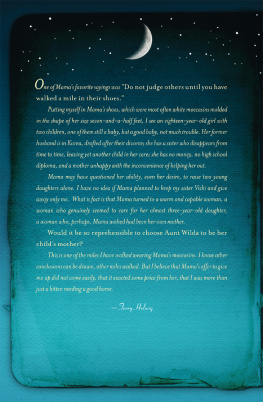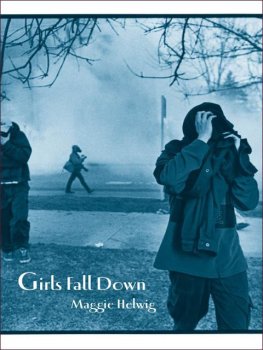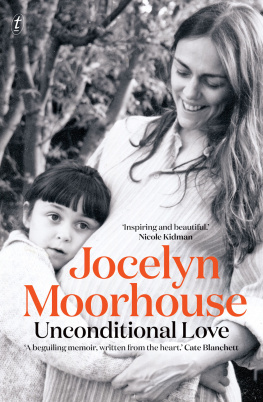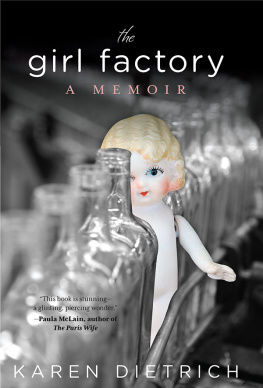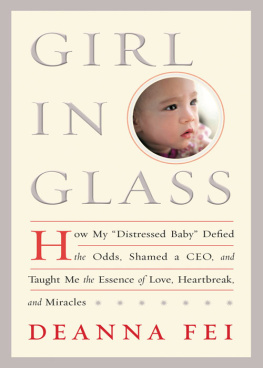
Thank you for purchasing this Simon & Schuster eBook.
Sign up for our newsletter and receive special offers, access to bonus content, and info on the latest new releases and other great eBooks from Howard Books.

or visit us online to sign up at
eBookNews.SimonandSchuster.com
Moonlight
on Linoleum


Howard Books
A Division of Simon & Schuster, Inc.
1230 Avenue of the Americas
New York, NY 10020
www.SimonandSchuster.com
In consideration of their privacy, the names and identifying details of some people have been changed.
Copyright 2011 by Teresa Helwig
All rights reserved, including the right to reproduce this book or portions thereof
in any form whatsoever. For information address Howard Books Subsidiary
Rights Department, 1230 Avenue of the Americas, New York, NY 10020.
First Howard Books hardcover edition October 2011
HOWARD and colophon are trademarks of Simon & Schuster, Inc.
The Simon & Schuster Speakers Bureau can bring authors to your live event. For
more information or to book an event, contact the Simon & Schuster Speakers
Bureau at 1-866-248-3049 or visit our website at www.simonspeakers.com.
Designed by Davina Mock-Maniscalco
Manufactured in the United States of America
10 9 8 7 6 5 4 3 2 1
Library of Congress Control Number: 2011016818
ISBN 978-1-4516-2847-0
ISBN 978-1-4516-2866-1 (ebook)
Contents
For
Carola Jean, my mother,
and Amanda Jean, my daughter
Foreword
Y EARS AGO, WHILE walking on a South Carolina beach with Terry Helwig, I had what turned out to be a propitious conversation. Close friends for over twenty years, we often walked the corridor of sand on Isle of Palms, talking about our lives and our work. On this October day, we were discussing the peculiar fact that many readers of my then recently published novel, The Secret Life of Bees, sometimes believed the story was based on my own childhood. They assumed that like my fourteen-year-old character, Lily, I had been forced to kneel on grits, had lost my mother when I was four, and had run away with the housekeeper to escape an abusive father. Of course, my childhood was nothing at all like Lilys.
After listening to my bemusement about this oddity, Terry said, If I wrote the story of my childhood, it would be just the opposite. The story would be completely true, but no one would believe it.
We laughed at this little irony.
I knew the saga of Terrys childhood, which rivaled the sorrow and crazy-making adversity Id invented for my own fictional Lily. Yet Terry had managed to arrive in adulthood with her soul beautifully intact, without a trace of victimhood, cynicism, or bitterness. Indeed, she was one of the most remarkable, loving, and utterly together persons Id ever met.
Walking beside Terry that day, marveling at how such a mysterious transaction as that occurs in the human spirit, I almost missed the tacit suggestion in her comment: If I wrote the story of my childhood.
My pace slowed till I was at a standstill. Have you thought of writing it?
Ive thought of it, she said. Butdoes the world really need another memoir?
It was just like her to ask that question. It would not occur to Terry to write a memoir just because she could. In her mind, it needed to exist for a larger reason; it needed to be the sort of story that served something worthwhile; it needed to be needed.
The world needs your story, I told her.
Ill think about that, she said.
We can all be glad she did.
It soon became apparent that Moonlight on Linoleum had been lying innate, dormant, and fathoms deep inside of Terry for most of her life, waiting for the right culmination of time and realization. For years, I watched from the periphery as she worked on the book, laboring to render her story with unflinching honesty, bringing to it her indomitable humor and humility, and filling it with her deep and luminous vision of life.
The book is both a tender recollection and an unblinking portrayal of a heartbreaking yet heart-stirring childhood, one that unfolds among the little oil towns of the American West. The transience, privation, abandonment, abuse, anguish, and havoc in Terrys young world is, startlingly enough, met with equal portions of hope, dignity, resilience, ingenuity, funniness, and love.
The story reveals a family hovering on the unraveling edge of life: Carola Jean, a complex and unforgettable mother whom you may want to rage at one moment and hug the next; a good-hearted, oil-drilling stepfather, plus an array of other colorful men held in Carola Jeans thrall. Terrys five younger sisters fall under her tutelage, in the formation of an uncommon sisterhood that transmutes suffering into salvation. And at the center of it is Terry, a girl clinging to hope in the face of crushing realities, a girl determined to stay connected to her dreams, determined to save her sisters, as well as herself.
If I were asked to explain the statement I made on the beach that day when I told Terry the world needed her story, I could probably come up with a whole panoply of reasons for why its true. But I will simply give you one....
Remember that mysterious transaction in the human spirit that I marveled at where Terry was concerned? The one that allows one person to transcend lifes hardships, becoming stronger, wiser, and larger in spirit, while another person succumbs to lifes injuries, growing hardened, contracted, or stuck? Well, there are no explanations for that, there are only stories. The world needs Moonlight on Linoleum because it is just such a story. It is what redemption looks like.
Sue Monk Kidd
Prologue
Riverside Cemetery
1990
I COULD NOT FIND my mothers grave.
The caretaker thumped a large brown ledger onto his desk. Whats your moms name?
An easy enough question, except for those five or six marriages. I should know her last name. My face reddened as I stood momentarily speechless in the caretakers office at Riverside Cemetery in Fort Morgan, Colorado.
She might be under Carola Jean Vacha, I said. I remembered letters spelling THE VACHAS running vertically down a post on the front porch of her marigold-colored house before she died.
The caretakers finger ran the length of the page. Nothing under that name.
In the fifteen years since Mamas death, I had not been back. I was unsure what name had been etched onto her headstone. Come to think of it, I couldnt remember being consulted about a headstone at all.
What about Carola Jean Simmonds? I asked.
He shook his head.
She married a lot, I offered. How about Wilton or Redding?
He raised an eyebrow and continued his search. Heres Carola Jean Redding. Died April 29, 1974. Lot 398, Block 10, he said and flipped the ledger closed.
I followed him as he wound his way through a maze of weathered gravestones variously carved with lilies, roses, and angels. The graves didnt all look alike to him; he knew about lots and blocks. He reminded me of the ferryman on the river Styx, overseeing the dead.
When he came to a stop in front of a flat cement marker, barely larger than a brick, I was confused. Then I saw it: Mamas name crudely etched into cement. She had no headstoneonly the plain dull marker the county had provided, which had begun to flake and crumble, surrendering to the surrounding grass.
Next page
